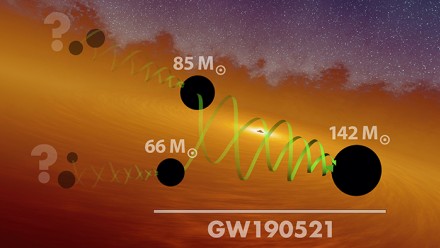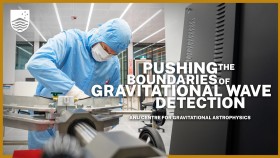Mammoth collision of `impossible’ black holes detected
 Artist's impression of black holes about to collide. Credit Mark Myers, ARC Centre of Excellence for Gravitational Wave Discovery (OzGrav)
Artist's impression of black holes about to collide. Credit Mark Myers, ARC Centre of Excellence for Gravitational Wave Discovery (OzGrav)
 This artist's concept illustrates a hierarchical scheme for the merging black holes of GW190521.(credit: LIGO/Caltech/MIT/R. Hurt (IPAC))
This artist's concept illustrates a hierarchical scheme for the merging black holes of GW190521.(credit: LIGO/Caltech/MIT/R. Hurt (IPAC))

Gravitational Wave scientists including scientists from the Centre for Gravitational Astrophysics (CGA) detected the most massive black hole collision that has ever been observed by the LIGO and VIRGO Scientific Collaboration. This event that was detected on 21 May 2019 is named GW190521. The signal came from two highly spinning, mammoth black holes weighing in at a massive 85 times and 66 times the mass of the Sun, respectively. They formed an even larger black hole weighing a whopping 142 times the mass of the Sun, by far the largest black hole ever observed through gravitational wave observations. The two black holes merged around seven billion years ago when the Universe was only about seven billion years old.
The mystery about this discovery is that the laregr of the two colliding black holes should have never existed in the first place. Astronomers predict that stars between 65 - 130 times the mass of the Sun undergo a process called pair instability, resulting in the star being blown apart, leaving nothing behind. With a mass of 85 solar masses, the larger black hole falls squarely in that forbidden range, referred to as the upper black hole mass gap, and should be `impossible'.
Furthermore, the resulting massive black hole, 142 times the mass of the Sun, is the first of its kind ever detected. Black holes of mass 100 to 100,000 solar masses are called intermediate mass black holes (IMBHs). They are heavier than stellar mass black holes but lighter than supermassive black holes often located at the centres of galaxies. There have been no conclusive electromagnetic observations for IMBHs in the mass range 100 to 1,000 solar masses. GW190521 confirmed that IMBHs can be produced through the merger of two smaller black holes.







